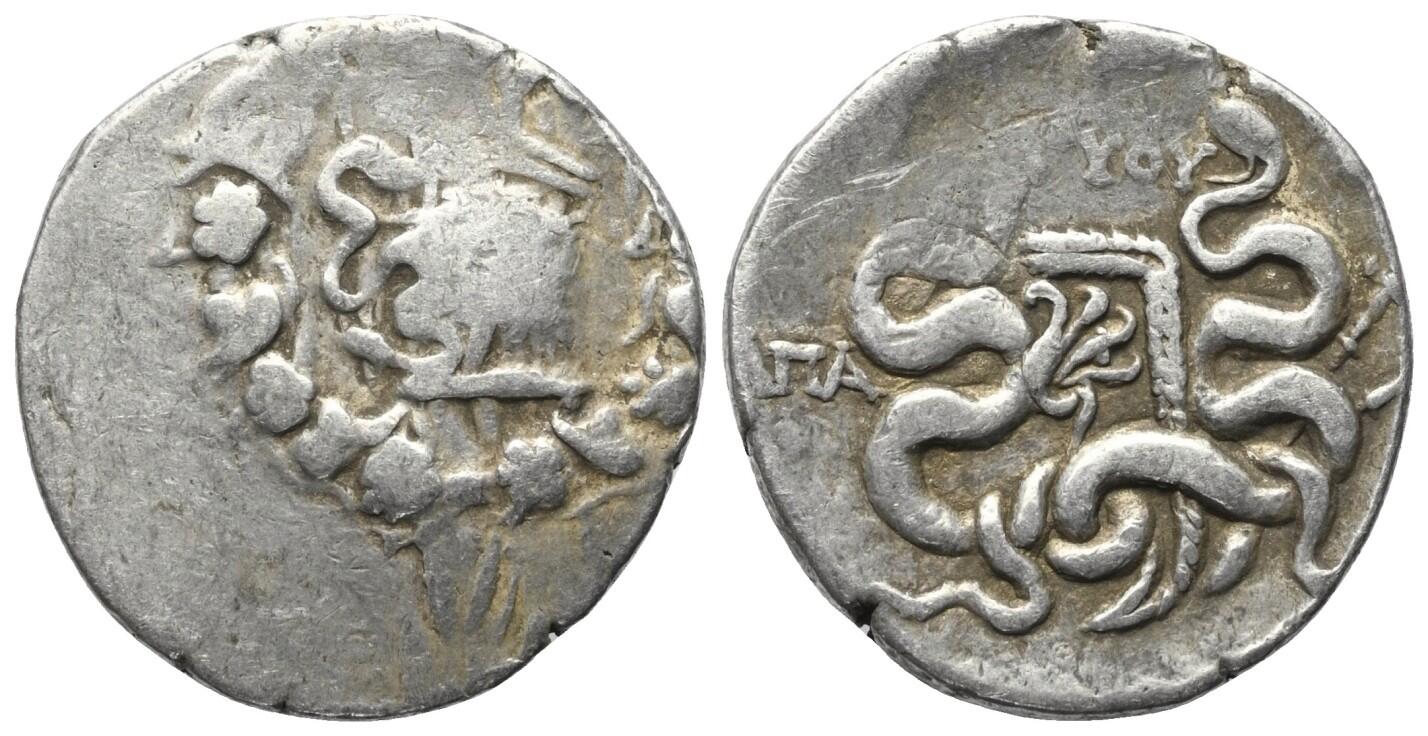H 252 - Apamea, silver, cistophori (90-67 BCE) Kleiner
From SILVER
90 BCE - 67 BCE Silver 11,128 kg
Description
| ObverseInscription or printing placed on the obverse.: | Cista mystica with serpent, all within ivy-wreath |
| ReverseInscription or printing placed on the reverse.: | ΑΠΑ (Greek).Two serpents entwined around bow and bowcase |
Mint and issuing power
| MintIdentifies the place of manufacture or issue of a numismatic object.: | Apamea | Ancient regionAncient region.: | Phrygia | Modern countryModern country: Turkey | AuthorityIdentifies the issuing power. The authority can be "pretended" when the name or the portrait of X is on the coin but he/she was not the issuing power. It can also be "uncertain" when there is no mention of X on the coin but he/she was the issuing power according to the historical sources: | Roman Republic |
Chronology
| FromIdentifies the initial date in a range assigned in a numismatic context. | 90 BCE | toIdentifies the final date in a range assigned in a numismatic context.. | 67 BCE | PeriodTime period of the numismatic object.: Hellenistic 323-30 BC |
Physical description
| MetalThe physical material (usually metal) from which an object is made.: | Silver |
Median weightMedian of the weights of numismatic objects (in grams). in grams | 12.50 | DenominationTerm indicating the value of a numismatic object. Examples: tetradrachm, chalkous, denarius.: | cistophorus |
StandardStandard.: | Cistophoric |
Image

H252 Apameia cistophori (90-67).jpg [1]
References
| Die study referencePublication of the study: | Kleiner 19791Kleiner 1979 | ||
| Coin series referenceReference to coin series study: | Sear II2Sear II, n° 5113-5114, RQEMH3RQEMH, n° 252 | ||
Obverse dies distribution
| FrequencyFrequency of specimen in distribution. ᵖ | Number of obversesNumber of obverse dies. ᵖ (o) | % (o) | Number of coinsNumber of coins. (n) | % (n) | Die nameName(s) of the die(s). |
| 1 | 8 | 20 | 8 | 4.04 | 4, 5, 13, 18, 20, 22, 28, 40 |
| 2 | 2 | 5 | 4 | 2.02 | 15, 16 |
| 3 | 8 | 20 | 24 | 12.12 | 12, 17, 24, 25, 26, 27, 31, 35 |
| 4 | 6 | 15 | 24 | 12.12 | 1, 3, 11, 14, 23, 36 |
| 5 | 2 | 5 | 10 | 5.05 | 7, 34 |
| 6 | 2 | 5 | 12 | 6.06 | 2, 10 |
| 8 | 5 | 12.5 | 40 | 20.2 | 6, 9, 21, 37, 39 |
| 9 | 3 | 7.5 | 27 | 13.64 | 8, 32, 38 |
| 10 | 2 | 5 | 20 | 10.1 | 19, 33 |
| 13 | 1 | 2.5 | 13 | 6.57 | 30 |
| 16 | 1 | 2.5 | 16 | 8.08 | 29 |
| Total | 40 of 40 | 100 | 198 of 198 | 100 |
Reverse dies distribution
no distribution is available
Quantification
| Number of obversesNumber of obverse dies. ᵖ (o) | 40 | Number of singletons (o1)The number of singleton coins. ᵖ | 8 |
| Number of reverse diesNumber of reverse dies. (r) | 168 | Number of coinsNumber of coins. (n) | 198 |
| Coins per obverse dieNumber of coins per obverse die. (n/o) | 4.95 | Coins per reverse dieNumber of coins per reverse die. (n/r) | 1.18 |
| Reverse per obverse ratioRatio of obverse dies divided by reverse dies. (r/o) | 4.2 | Percentage of singletons (o1)number of coins (n) divided by the number of singletons (o1) ᵖ | 20 % |
| Original number of dies (O) (Carter 1983 formula)The estimation of the number of coins according to Carter 1983 ᵖ | 44.51 | Coins struck if 20,000 as average productivity per dieCoins made if the average productivity for obverses (according to Carter) is 20,000. ᵖ | 890,200 |
| Original number of dies (O) (Esty 2011 formula)The estimation of the number of coins according to the singleton formula in Esty 2011 ᵖ (O) | 50.13 | Survival rate if 20,000 as average productivity per dieSurvival rate if average productivity is 20,000. ᵖ | 0.00022 |
| Coverage (o = % of O) (Esty 1984 formula)Esty 1984 - coverage (% of O) ᵖ (o = % of O) | 95.96% | Die productivity if survival rate 1/2,000Average productivity if survival rate is 1/2,000. ᵖ | 8,896.88 |
| Weight of silver (in kg) if 20,000 coins per die (O = Carter formula)Carter 1983 * Median weight * 20000 (*10 if gold or electrum) ᵖ | 11,128 kg <br /> 11,128 kg | Die productivity if survival rate 1/5,000Average productivity if survival rate is 1/5,000. ᵖ | 22,242.19 |
Remarks
Most likely one single workstation